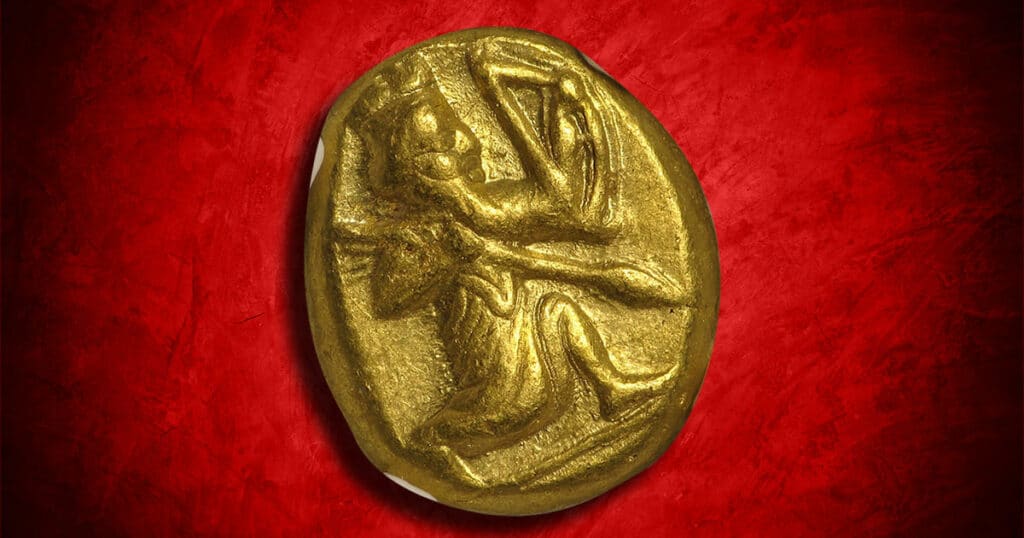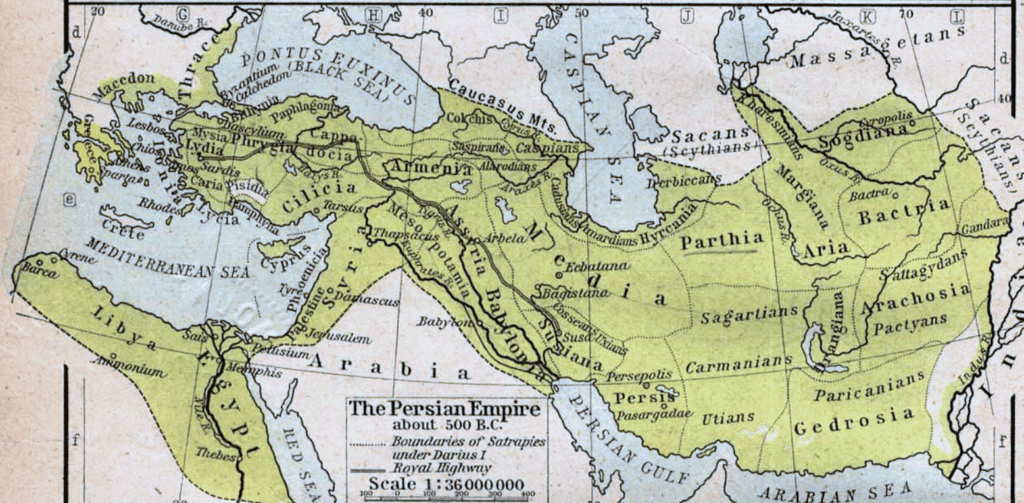
History has not been kind to King Darius or to the Persian Empire itself. The Persian (or it is also known as the Achaemenid Empire) was the largest empire in the known world around this time period of approximately 500 BC. The Persian Empire extended from Egypt in the South and West to northern India in the North to Central Asia in the East.

(The Massive Persian Empire around 500BC)
They were explorers and warriors and were not afraid to take the lands and subjugate the peoples that they met. To the East, the Lydians, under the leadership of King Croesus, envied the Persian Empire and sought to conquer some of their lands. Croesus was well-known in the primitive world as a fierce warrior, and he first struck gold coinage. Croesus struck coins with his likeness on them, and he was, at one time, the richest man in the primitive world, having literally thousands of pounds of Gold that he had turned into coins.
Croesus led his army into battle against the Persians. As winter neared the Lydians withdrew their army, but the Persians did not follow suit. Instead, they advanced and placed the Lydian capital at Sardis under siege. After a two-week siege, the city fell and was overwhelmed by Persian forces. The Lydians had been strong allies of the Egyptians and Babylonians. Now the Persian army had to face those forces as well. Neither the Egyptians nor the Babylonians were a match for the growing Persian army. Lead by King Cyrus, the Persian army seemed invincible. But Cyrus died leaving his ill-equipped son, Cambyses, to lead the army
Cambyses continued his father’s success on the battlefield. But shortly after the victory over the Egyptian army at the ancient city of Memphis, the Persian King Cambyses died, and Darius assumed control of the Persian army and

(Bas Relief of Darius I, Darius the Great, King of Persia)
Darius ruled Persia from 522 BC 70 486 BC. During that time, the Persian Empire was at the height of its power and at its largest geographical size. Darius was a good ruler, who cared about his people. He built roads and appointed a system of Governors to rule each segment of the Empire.
As the Persian Empire was prospering, some of the vanquished tribes revolted against Darius’ rule. Several parts of the Ionian Islands rebelled, and it took a 4-year war against these factions to quell the revolt. As Darius I died, rule of the Persian Empire went to 2 other kings as well as to relatives such as his son, Darius II, and to his cousin, Darius III.
Like all empires, they have their apex, and they also have their lowest point as well. The Persian Empire ruled the land for nearly 2 centuries as the most powerful Empire and army in the known world. But around 330 BC, the Persian Army was met in battle by the army of Alexander III of Macedon, known as Alexander the Great. This brilliant Greek general was able to not only defeat Darius III, but he was able to conquer the Persian Empire, but he did so at a great cost to himself and his armies. Alexander the Great had to fight in virtually every province in the Persian Empire and subdue that province and move on to the next. This process was finally accomplished after a 3-year struggle across all the lands conquered by Persia.

(Alexander the Great conquering the Armies of the Persian Empire.)
As Alexander the Great subjugated the Persian Empire, he did one thing that many conquering kings did. He gathered as many Gold Persian coins as he possibly could as tribute and as bounty and melted them and re-struck them in his own image.
The Gold Persian coins that had been struck for two centuries and were spent from Egypt to Asia were called Darics, after King Darius I. The coins were similar in that they depicted their most illustrious king – Darius I. He was always depicted running – symbolizing moving his armies swiftly across and capturing the known world. He was also depicted carrying a bow and arrow as well as a spear. This symbolized his great fighting ability and that of his great and successful army. The reverse is simply an incuse punch used during the minting process.

(Gold Daric Coins of Persia, depicting King Darius I.)
These Daric gold coins were exchanged for Macedon Gold coins. The Daric coins were gathered and melted. They were then re-struck, but now bearing the head of Alexander the Great. Persian Daric gold coins are especially scarce for that reason. The conquering Macedons sought to eliminate them from their new empire. The coins that were able to survive to today were hidden for centuries and they escaped in very limited numbers.





